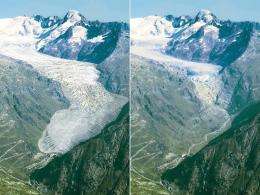Do Atlantic currents affect Alpine glacier melting?

Natural climate fluctuations such as variations in the Atlantic currents probably influenced glacier retreat in the Alps in the last century more than we first thought: they correlate with times of particularly striking glacial retreat, but also with times of growth. This is shown in a new study of Swiss glaciers.
Nowhere in the world is the array of observations carried out on glaciers as comprehensive and long as in Switzerland. For more than 100 years the Swiss glaciers have been observed, more and more new topographic maps compiled, aerial photographs taken and measurements made on the glaciers. This collection of survey data can be used to verify how much mass the glaciers are losing and how severely they have been affected by climate change up to now. The data also provides a basis on which to forecast future glacier retreat and its consequences.
The consequences of shrinking glaciers
Glacier melt-water has a decisive effect on energy generation by hydroelectric power stations in Switzerland. Melting glaciers also change the landscape’s appearance and could harm the tourist industry. Matthias Huss, a former doctoral student of the glaciologist Martin Funk, Professor and Head of the Glaciology Department at the Laboratory of Hydraulics, Hydrology and Glaciology (VAW) at ETH Zurich, says that the sea level could rise by up to half a metre worldwide purely as a result of melting mountain glaciers.
Together with ETH Zurich glaciologists Martin Funk and Andreas Bauder, as well as a colleague from Alaska, Huss has compiled all the available data on thirty Swiss glaciers of various sizes: for each glacier this involves up to nine digital terrain models providing information about how the volume of ice has changed over the course of time. Added to this are more than 10,000 measurements made directly on the glaciers during the past century. All this data forms the basis for a model which can be used to determine the development of the glaciers since 1908 at high temporal and spatial resolution.
Not transferable to all glaciers
The results show that the individual glaciers lose mass at different rates. Martin Funk stresses that the results are unexpected, and it is not clear why some glaciers lose ice more quickly and others more slowly. More research is needed here. “This is why we must be careful when transferring the results to a whole mountain range or even to other glacier regions in the world,” says Funk. However, all of the 30 glaciers that were studied in this case receded significantly and lost a total of about 30 percent of their mass.
The scientists also compared the time series of glacier mass loss with an index that is known as the Atlantic Multidecadal Oscillation (AMO). The AMO is a natural phenomenon in which the surface temperature of the Atlantic rises and falls again in cycles of about 60 years. The cause of the oscillation is still not entirely clear. Huss explains that it is probably associated with periodic natural variations in the ocean currents.
The researchers report that the mass balance of the Swiss glaciers correlates with the AMO. The AMO can explain the periods of especially marked glacier retreats, e.g. in the 1940s and since the 1980s, as well as the stagnation or growth during and the 1910s and in the 1970s. This indicates that the ocean surface temperatures in the Atlantic were above average during periods of rapid glacier shrinkage and vice versa. The researchers say the prevailing conditions in the Atlantic are currently speeding up glacier shrinkage. This leads us to the conclusion that up to half of the recently accelerated mass losses could have been caused by natural climate fluctuations.
Anthropogenic influence is intensifying
At the same time, the glaciologist Matthias Huss, now at the University of Fribourg, warns against false conclusions: “The cause of the sustained glacial shrinkage trend in the last hundred years has an anthropogenic origin, a result of the increase in the level of CO2 in the atmosphere.” However, the periodic deviations from the average mass loss have been intensified or weakened by various natural causes.
Only last December, Huss, together with Professors Funk and Ohmura of ETH Zurich, published a study in which they showed that glaciers melted at a faster rate in the 1940s than they do nowadays, and that glacier melting is influenced by long-term changes in solar radiation. These radiation changes correspond to the so-called “global dimming” and “global brightening” phenomena and are associated with an increase and reduction respectively in the pollution of the atmosphere by aerosols.
More information: Huss M, Hock R, Bauder A & Funk M: 100-year mass changes in the Swiss Alps linked to the Atlantic Multidecadal Oscillation, Geophysical Research Letters (2010), 37, L10501, doi:10.1029/2010GL042616
Provided by ETH Zurich

















